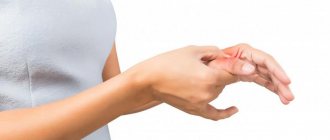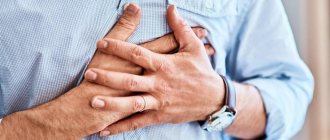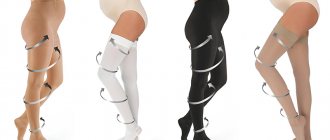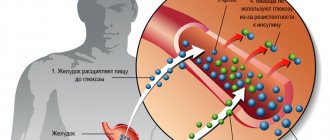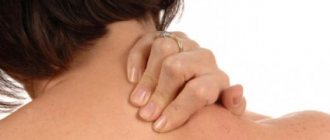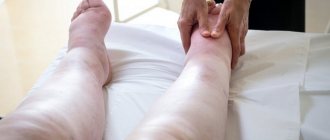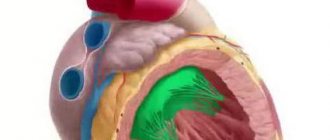When are seizures dangerous?
Muscle spasm can be a symptom of a serious malfunction in the functioning of one or another internal organ or the body as a whole.
For example, liver cirrhosis, type I diabetes mellitus, and developing neurological disorders, in particular epilepsy, often make themselves felt by seizures. There is another danger. A spasm can affect not only large muscles, but also smooth muscles that make up the membranes of internal organs. Spasms of such muscles are sometimes fatal. For example, spasm of the bronchi can lead to respiratory arrest, and spasm of the coronary arteries can lead to a deterioration in the functioning of the heart, or even cardiac arrest.
Experts from the Mayo Clinic Research Center recommend Muscle cramp to seek medical help as soon as possible if cramps:
- They happen often—several times a day or several days in a row. This is a reason to be wary and consult a specialist.
- Cause serious, almost unbearable discomfort.
- Accompanied by swelling, redness or any other changes in the color and structure of the skin.
- Combined with high fever and headache.
- Causes severe muscle weakness.
If you do not observe any of the listed symptoms, you can exhale: most likely, the spasms will not threaten you with anything dangerous. Nevertheless, it is still worth understanding their origin. At least in order to save yourself from such painful sensations in the future.
Hand cramps
A common phenomenon among those who work physically. No less often, knowledge workers - musicians, managers and other people who spend a lot of time at the computer - complain of spasmodic attacks. In the first case, spasms are caused by muscle overstrain and occur more often at night. Patients complain of waking up at night due to pain in their arms. In the second, painful sensations can occur at any time of the day.
Spasms of the upper extremities can be triggered by hypothermia and tight sleeves of clothing. These factors slow down blood flow, muscle fibers do not receive enough oxygen and nutrients, and therefore contract spastically. Muscular hypertonicity can be observed after intense physical training. Often the cause is monotonous movements during needlework and other activities related to fine motor skills of the hands.
All situations develop due to overstrain of the arm muscles
What can be done? If you can’t work less, you should pay attention to the content of vitamins and microelements in food and water consumption. Cramps are caused by a lack of calcium and magnesium with iron
Taking diuretic drugs increases the risk of developing convulsive syndrome. That is, you need to eat right, including iron-containing foods, fruits, and vegetables in your diet.
A few simple movements will help relieve a sudden spasm. If your hand is cramped, you need to shake it vigorously several times and also clench your fingers into a fist. Then move them, simulating typing on a keyboard. A massage with simultaneous forced flexion of the little finger gives a good effect. You can also take a relaxing hot bath.
If seizures recur regularly, consultation with a neurologist is necessary. Spasms and numbness of the left hand deserve special attention - they are often a harbinger of myocardial infarction.
Cramps in the arms and legs: causes of muscle spasms and their treatment
The cause of muscle spasm can be anything: from physical overexertion to the presence of a malignant tumor. If involuntary muscle contractions occur frequently, you should consult a doctor. Single spasms can be relieved on your own at home; recurring ones require examination and appropriate treatment.
Definition
A cramp is an involuntary contraction of striated or smooth muscle fibers, accompanied by pain. The work of skeletal muscles is regulated by the central nervous system by direct and reverse impulses. If one of the chain links malfunctions, uncontrollable spasms are observed.
Any muscle can contract pathologically, but most often patients complain of damage to the limbs. Pain during a cramp occurs due to pinched nerve fibers with a sharp increase in muscle tone. It can be either short-term or persistent, up to long-term disability.
Varieties
Spasms of skeletal muscles are divided into tonic and clonic; a mixed version is also possible.
The first type is a prolonged tension of muscle fibers, in which the spasmed muscle changes shape and is fixed in this form for some time.
Intense pain occurs, which either goes away after relaxation or persists (sometimes for quite a long time).
This type of spasm is caused by overexcitation of the subcortical areas of the brain. A characteristic feature of tonic muscle cramps is their occurrence at night, during periods of rest.
Clonic contractions appear as twitching, which is explained by the alternating contraction and relaxation of muscles.
The reasons that cause them are varied, but they all lead to stimulation of the cerebral cortex.
When a specific muscle area is affected, trembling is observed; in the case of a generalized seizure, the entire body is affected. The latter is observed during a classic epileptic attack.
Common reasons
Various factors influence muscle tone. Cramps of the limbs or the whole body occur for the following most common reasons:
- Epilepsy and other neurological disorders, especially in the elderly.
- Infectious diseases affecting the nervous system (tetanus, for example).
- Brain cysts and tumors.
- Intoxication – mushrooms, salts of heavy metals, medications.
- Neurotic states such as psychosis.
- Deficiency of certain microelements due to water-electrolyte imbalance.
- High fever in children under 6 years of age.
Physiological factors can also cause the disorder. Twitching of the hands after strenuous work with the hands in those who work physically or spend a lot of time at the keyboard. Cramps also occur after intense physical training (strength training).
Hypothermia is another possible cause of muscle spasms. Tonic contractions of muscle fibers can affect both internal organs (in this case, their work is disrupted) and skeletal muscles. Leg and hand cramps may have the same causes.
Diagnosis and treatment
The listed first aid measures are intended solely to relieve painful cramping, but its causes may require special treatment. Often spasms are a symptom of serious diseases, so their regular nature requires a full examination.
Diagnostics includes physical examination, laboratory and instrumental research methods. Based on their results, appropriate treatment is prescribed.
Medicines
Knowing the causes of pathological contractions, you can get rid of them using various groups of medications. According to indications, the following may be prescribed:
- Benzodiazepines (Phenazepam), which relieve nervous excitement, muscle spasms, have a sedative effect.
- Neuroleptics - Aminazine - help cope with insomnia, psychosis, and moderately lower blood pressure.
- Cardiac glycosides such as Digoxin are indicated for heart failure and poor circulation.
- Iron and magnesium supplements for deficiency of these microelements.
- Fibrinolytics are used in cases of convulsive syndrome caused by ischemic stroke to destroy the blood clot.
In early childhood (up to 6 years), specific febrile convulsions caused by increased temperature may occur. Treatment in this case comes down to taking antipyretics and NSAIDs.
Physical exercise
If cramps in the legs and hands occur due to overwork, heavy or monotonous work, you should rest as much as possible.
You need to sleep at least 6 hours, take a warm shower or a relaxing bath before bed. It is advisable to lift weights in several stages, in small parts.
Take regular breaks at work at least once an hour; gymnastics will be useful to relieve tension in your hands and fingers.
When playing sports, especially strength sports, you should dose the load wisely and also do a warm-up to warm up.
Nutrition
Diet is critical for iron, magnesium and calcium deficiency. The deficiency of these microelements is determined during a blood test. Along with taking special medications, it is recommended to adjust your diet. Red meat, liver, buckwheat, pomegranates and apples will help compensate for the lack of iron in anemia.
There is a lot of magnesium in fresh vegetables, legumes, nuts, and calcium in dairy products. It is important to maintain a drinking regime, consuming enough liquid. But at the same time, it is better not to drink carbonated and tonic drinks.
Surgery
If the seizure syndrome occurs due to the presence of tumors, abnormalities or vascular diseases, surgical intervention is necessary. During the operation, tumors, blood clots, and sections of veins (for varicose veins) are removed. In case of obliterating endarteritis, bypass surgery is performed to restore vascular patency.
Folk remedies
Alternative medicine offers many ways to relieve and treat muscle cramps. First of all, it is recommended to carry out warming procedures: compresses, salt baths, apply mustard plasters or pepper plaster.
You can take an infusion of linden blossom, adonis, or a decoction of viburnum bark internally. The latter is also used to rub the muscle areas affected by spasms. Therapy with folk remedies has contraindications and can only be used with the approval of a doctor.
How to treat seizures
If cramps cause you discomfort (wake you up at night or last for quite a long time, despite massage and compresses), go to a therapist. To identify problems with your body, your doctor will ask you several questions. For example:
- How often do you have cramps?
- What muscles do they affect?
- Are you taking any medications?
- How often do you drink alcohol?
- What is your lifestyle and physical activity like?
- How much fluid do you drink daily?
Blood and urine tests may be required for a more complete diagnosis. With their help, the doctor will find out the level of microelements and will also be able to check the condition of the kidneys and thyroid gland. In some cases, electromyography is prescribed. This is a test that measures muscle activity and diagnoses existing muscle disorders.
As a result, the doctor will determine the disease, the symptom of which is seizures, and prescribe specific treatment.
Reason: pregnancy
Pregnancy is not a disease, but it also cannot be ignored, since the processes occurring in the body of a pregnant woman, whose task is to provide the fetus with everything necessary, lead to metabolic disorders, change hormonal levels, impede blood circulation in the vessels of the pelvic organs and lower extremities and thereby contribute to because the muscles periodically cramp. Thus, the cause of seizures during pregnancy is considered to be:
- Lack of vitamins and microelements;
- Development of anemia;
- Increased blood glucose levels (gestational diabetes);
- Varicose veins of the lower extremities and venous congestion;
- Failure to comply with the diet, work and rest regime provided for pregnant women;
- Limitation of physical activity (concern for maintaining pregnancy - forced on the recommendation of doctors or organized on one’s own initiative).
It will be better if a doctor prescribes treatment for such a scourge in pregnant women. He will carefully collect anamnesis, conduct a biochemical blood test, check blood circulation in the vessels, assess the general condition of the body and advise in which direction to move: it will be enough to balance the diet, saturating it with the missing microelements, or you will have to undergo treatment in a hospital setting.
Dangerous moments
Seizures affect the body at any age; the likelihood of their occurrence is determined by the action of provoking factors.
- Young children are more susceptible to functional neuronal disorder due to the physiological characteristics of brain development. Even a single manifestation of febrile convulsions caused by an increase in body temperature during an infectious disease is a reason to immediately seek qualified medical help. Subsequently, such children require observation, especially at the time of the onset of infectious diseases. In this case, pediatricians recommend reducing body temperature with the help of antipyretics when crossing the mark of 37.5? C. Gluten intolerance (celiac disease) is an equally common cause of seizures in infancy.
- Patients with a history of diseases of the endocrine, cardiovascular, and central nervous systems require constant monitoring. Generalized muscle spasm can be fatal. To prevent the occurrence of sudden seizures that occur frequently or constantly, it is necessary to take drugs that reduce the increased excitability of the subcortical region of the brain, prescribed by the attending physician.
- Late gestosis is a dangerous condition observed in the third trimester of pregnancy. Convulsions in this case can be either tonic or clonic. High blood pressure increases the risk of cerebral edema, which can have irreparable consequences. Pregnant women at risk should visit a gynecologist more often and receive drug treatment: drugs that prevent hypertension and muscle spasms. A gynecologist-endocrinologist will tell you which pills you can take for tremors and leg cramps with the least negative effect on the developing fetus.
- Hormonal imbalances caused by thyroid disease, or its absence as a result of surgical treatment, increase the risk of seizures. Such patients are automatically at risk and require constant monitoring.
- Brief convulsions are a manifestation of epilepsy. A convulsive epileptic seizure causes synchronous excitation of all neurons (nerve cells). Disturbances in the conduction of nerve impulses are observed with the appearance of abnormally active genes (hereditary predisposition to epilepsy), autism, Lafora's disease, Alzheimer's, stroke, alcoholism, infection, trauma. The severity of spasms depends on the cause of their occurrence, the scale of the lesion, and timely symptomatic therapy. In most cases, a seizure lasts no longer than 5 minutes, after which the victim feels completely powerless or anxious, without remembering what happened. An epileptic seizure is accompanied by foaming at the mouth, cold sweat, spontaneous urination and defecation. The risk of injury to the body is quite high, so assistance should be provided to the victim at the first signs of a seizure.
Causes of leg muscle cramps in healthy people
If your leg muscles often cramp, the cause may be increased stress on the lower limbs. The pathology is often found among sellers, surgeons, athletes, and hairdressers. In people leading a sedentary lifestyle, blood circulation is impaired and muscle tissue weakens, so after intense sports or long walking, painful spasms may occur.
Nighttime contractions often occur in women who wear high-heeled shoes or tight shoes that cause calluses. Hypothermia, adherence to a strict diet, and increased sweating can be a provoking factor. Cramps often appear in the morning when a person begins to stretch while getting out of bed. Leg cramps often bother people when immersing their body in cold water. Low temperatures slow blood circulation, causing painful cramping in the toes, feet, and calves.
In children
Muscle twitching in babies is observed with high body temperature, fever, and after vaccination. At risk are premature babies, children who have suffered birth trauma, exudative diathesis, and asphyxia. The pathology is associated with the immaturity of the nervous system. Physiological reasons include increased physical activity, unbalanced nutrition, vitamin deficiency, flat feet, and hypothermia.
Newborns whose mothers drank alcohol, drugs, or barbiturates during pregnancy develop withdrawal syndrome.
In addition to a disturbance in the general condition of infants, on days 3–5 of life, excessive excitability is noted: children intensively suck their fingers, they have increased skeletal muscle tone, tremors, convulsive readiness or convulsions are recorded.
In middle aged people
Muscle spasms are most often diagnosed in men over 35 years of age. The cause may be a hidden disease of internal organs, alcohol abuse, an unbalanced diet with a predominance of animal fats, and physical inactivity. The pathology often progresses after fractures of the lower extremities, surgery, against the background of chronic fatigue, frequent stress, and overwork.
In older people
With age, metabolic processes slow down in the human body, tissues regenerate worse, muscles become weaker due to decreased mobility, and joints suffer. Due to natural aging, taking medications, the presence of chronic diseases, and excess body weight, leg cramps may occur. Diabetics, patients with atherosclerosis and liver damage are especially often affected.
Causes of seizures
The causes of muscle cramps can be very diverse:
- infectious diseases of the brain and spinal cord;
- developmental defects;
- traumatic brain injuries received in the perinatal period;
- cyst, brain tumor (including cancer);
- CNS diseases;
- diseases of the heart and circulatory system;
- increased body temperature (febrile convulsions in early childhood);
- high physical activity;
- prolonged stay of muscles in one position;
- violation of the water-salt balance as a result of a lack of potassium, calcium and magnesium in the body;
- vitamin B6 deficiency;
- sedentary lifestyle;
- irrational use of medications (toxic seizures);
- gestosis in pregnant women;
- hypoglycemia;
- body exposure to cold water;
- psycho-emotional instability (hysterical convulsions);
- drinking alcohol in toxic doses;
- smoking;
- hereditary predisposition (epilepsy).
Cramps are observed in both striated muscles and smooth muscles.
If a muscle spasm manifests itself as a sudden attack and lasts for a long time, such spasms are called tonic. Changes in muscle tone in the form of spontaneous twitching are classified as clonic convulsions. It is tonic spasms that cause prolonged severe painful sensations, which in some cases (spasm of the jaw muscles, tongue) make breathing difficult and can cause death.
Muscle cramps are most often observed in the extremities, but they can also appear in other parts of the body.
| Convulsions | |
| Tonic | Clonic |
| Trismus (spasm of masticatory muscles) | Convulsion (generalized spasm of body muscles) |
| Blepharospasm (convulsive contractions of the orbicularis oculi muscles) | Cardiospasm (spasm of the esophagus at the junction with the stomach) |
| Pylorospasm (spastic contraction of the stomach muscles, more often in newborns) |
Body aches associated with muscle cramps are more likely to occur at night. If your limbs go numb during sleep, it is enough to change your position to eliminate the discomfort. Short-term painful sensations may occur as a result of fatigue or exposure to low temperatures (leg cramps). Spasms of the leg muscles are familiar to pregnant women, as the load on the legs increases and hormonal changes occur in the body. If the listed phenomena are not repeated and resolve on their own when the provoking factors are eliminated, there is no reason to worry.
Why muscles cramp: 5 problems and their treatment
Cramps are uncontrollable contractions of the muscle system, which are often accompanied by pain. A muscle in a convulsive state becomes dense and hard, its shape may also change, and twitching is noted. If the attack is severe, muscle pain often persists for several days.
When faced with such inexplicable pain for the first time, a person often experiences fear: what to do to prevent the pain from happening again. Some people are familiar with cramps from childhood, others experience this disease in adolescence or even adulthood, and they often bother pregnant women.
At any age, it is necessary to get rid of them - after all, they significantly worsen the quality of life.
The concept of “convulsive syndrome”
Muscle spasms (cramps) or convulsions are involuntary contractions of muscle fibers that limit movement and cause severe pain. Convulsions are a reaction to certain pathological changes in the body. Based on localization, they can affect a specific part of muscle tissue or an entire group.
At the time of convulsions, the muscle hardens and is in a tense state. Cramps can occur in any part of the skeletal muscle, but the gastrocnemius and thigh muscles are often affected.
Which muscle groups cramp most often?
An involuntary spasm can affect any muscle and its groups. Among the skeletal muscles of our body, the muscles most often spasm are those in the legs, which take part in the movement of two joints at once (the calf muscles, as well as the front and back of the thigh). By the same principle, uncontrolled contractions can affect the feet and hands.
Sometimes the smooth muscles of internal organs can contract with spasms. The most common spasms of the intestines, vascular walls and bronchi occur. Smooth muscle contractions can be as painful as skeletal muscle spasms.
Minor Factors
Cramps in the legs and arms can be triggered by a person’s lifestyle and professional activities; a group of people are more often susceptible: athletes, workers, people leading a sedentary lifestyle. Long-term smokers, coffee and alcohol drinkers suffer from cramps.
Also, while swimming in cool water, muscles can tighten, preventing movement, which can lead to tragic consequences.
Insufficient fluid intake (dehydration or excessive sweating) is a minor factor in painful muscle contractions.
Cramps can begin during sports, swimming, walking, while sitting, or even while a person is sleeping.
Pathology of seizures
Complaints come from patients that the muscles of the whole body have contracted during sleep. Only a doctor can explain the reason and make a diagnosis. The appearance of spasms is influenced by the following pathological factors:
- Severe convulsive syndrome is characteristic of tetanus (opisthotonus). This disease can be fatal.
- Brain cyst.
- Past infections.
- Encephalitis, inflammation of the brain centers and membranes.
- Epileptic state.
- Head injuries.
- Tumors.
- Convulsive spasms against the background of neuroses.
- Intoxication due to poisoning with high fever in children.
- Overexcitation of nerve cells in the brain.
- Muscle strain.
- Birth and intrauterine injuries in newborns.
- Eclampsia during pregnancy.
In these and other cases, the therapist refers the patient for examination to a neurologist and neuropathologist.
Only with a thorough examination can the factors provoking the occurrence of convulsive syndrome be determined.
A muscle cramp can range from minor twitches to violent contractions with severe pain.
Dehydration
“Dehydration disrupts the electrolyte balance, which is necessary for the transmission of nerve impulses to muscle fibers. When you drink too little, false positives are possible, the expert warns.
“The body doesn’t know whether the signal came from the brain or whether something has short-circuited in the local cells due to an electrical imbalance.” The result is a painful spasm from too strong muscle contraction.
Fortunately, this is easy to prevent: drink, drink, drink! Clean water is too beneficial to be neglected.
Types of muscle spasms
According to the nature of the manifestation, seizures can be strong and prolonged, repeating several times a day. In severe cases, unbearable pain is possible, including loss of consciousness. After an attack, pain in the affected area persists for several days.
If the spasm is caused by a lack of microelements in the blood (calcium, magnesium, potassium), then drug treatment is aimed at replenishing them and changing the diet. Such therapy has a positive effect on the patient’s condition in a short period of time.
Nighttime manifestations of muscle cramps are affected by diseases such as varicose veins, diabetes mellitus, disorders of the endocrine or nervous system, atherosclerosis, stressful situations, lack of vitamins and impaired blood flow in the muscles.
Unusual load
It is, of course, unbearable to remain idle when your favorite painting on the wall is askew, but the result of careful alignment of a heavy frame can be not only the ideal position of the masterpiece, but also unpleasant cramps in the arm or back. Just imagine, being stuck in an uncomfortable position for a long time often ends in a spasm.
“Load for which the body is not prepared leads to microdamage to muscle fibers,” teaches Dr. Danesh. “The process produces lactic acid, which causes the muscles to contract painfully.” But it’s easy to get rid of this type of cramps, and even with health benefits - regular exercise will help.
But if the spasms do not go away for several hours and even interfere with sleep at night, it is better to see a doctor .
Convulsive spasms in children
Seizures in children are observed 2 times more often than in adult patients.
A common cause of convulsive muscle contractions in children is the immaturity of various parts of the brain and the thermoregulation center, and hyperthermia can also provoke their appearance.
In addition, muscle spasms can begin from other factors:
- Viral and bacterial infections.
- Heat.
- Head injuries.
- Brain hemorrhage.
- Poisoning with chemical or toxic substances.
- Hereditary factor.
- Metabolic imbalance.
If you have frequent and regular seizures lasting more than 15 minutes, you should immediately consult a doctor. Only a doctor can determine and prescribe the exact cause and treatment.
Convulsive syndrome can involve any muscle group: respiratory, chewing, laryngeal, facial. Regardless of where the muscles cramp, you should definitely consult a therapist, as this can lead to serious illnesses.
In what cases should you consult a doctor?
If your legs cramp very often and/or the spasms do not stop for a long time, you should think about visiting a doctor. You should be especially wary of the situation when cramps occur without any physical activity.
Source: https://neuro-orto.ru/simptomy/pochemu-svodit-myshcy.html
Traditional medicine tips
Tablets, ointments and herbs used independently for seizures require prior consultation with your doctor. After a comprehensive examination of the body, the doctor will explain why spasms occur, what herb or ointment helps with leg cramps during the day and at night, eliminates heaviness in the limbs, and how effective the therapy will be.
- Traditional methods of treating muscle cramps at home include a balanced diet aimed at replenishing essential microelements. Your daily diet should include foods such as cottage cheese, hard cheese, peppers, dried apricots, avocado, green onions, dill, parsley, wheat bran, and seaweed.
- An effective cure for night cramps in the arms and legs is mustard powder
, which can be purchased at any pharmacy. If cramps occur or your feet are cold, pour mustard powder into thick socks and put them on at night. This procedure can be carried out for several days in a row until the discomfort is eliminated. Mustard will help against the appearance of cramps in the arms and legs in the absence of contraindications: some mental illnesses, allergies, wounds. Mustard oil (pharmaceutical) has a milder effect; it can be smeared on the upper and lower extremities before bed to prevent another attack. - Tablets prescribed against cramps of the arms and legs
can be replaced with a decoction of linden, birch buds, adonis, thyme, if the spasms are mild. To prepare the decoction, pour a tablespoon of dry raw material into 0.5 liters of water and boil for 5 minutes. Then leave for 30-40 minutes and consume 4 tbsp. spoons 3-4 times a day. You can drink the herbal decoction for 7-10 days. - If your fingers cramp,
traditional medicine advises using a contrast shower for preventive purposes. The feet are alternately dipped in a basin of cold and hot water, and then thoroughly dried with a terry towel. For the treatment procedure, it is better to take a towel with large, hard bristles in order to perform massage movements more effectively. This therapy is carried out symptomatically.
The effectiveness of treatment depends on the cause of seizures, the presence of systemic diseases, timely and adequate therapy. Traditional medicine is used symptomatically; they do not replace the traditional treatment regimen for convulsive conditions. If muscle spasms recur repeatedly, consultation with a doctor is mandatory: many diseases have hidden symptoms at an early stage of development.
Associated symptoms and diagnosis
Arm and leg cramps usually present with characteristic symptoms. Patients may not always notice their presence, but upon examination by the attending physician, it is quite easy to identify them. Much depends on the presence or absence of pathology - in this case, on the contrary, the clinical picture of the underlying disease is supplemented by the presence of seizures.
The most common symptoms include:
- Pain is most pronounced at the peak of a cramp, when a burning, bursting pain is noted in the affected area of the arm or leg. Sometimes the pain is so severe that the patient may moan or scream,
- Decreased pulsation is noted due to compression of the artery by the muscle and is temporary during the attack. Measured on the radial and popliteal arteries,
- Changes in temperature and skin color - this symptom varies depending on the time of the attack. At the initial stages, the skin is pale and cold, but after a few minutes there is a rush of blood and redness in certain areas of the legs and arms,
- Loss of coordination - observed after a convulsion, when, due to the pain suffered, it is difficult for a person to move or carry out basic self-care skills.
In addition to complaints, instrumental and laboratory research methods are valuable for diagnosing the causes of seizures. In most cases, they indicate the presence of chronic pathologies in the body. These include:
- Blood tests (to detect potassium and magnesium deficiency),
- General urine analysis,
- ECG (electrocardiogram),
- X-ray or CT (computed tomography) scan of the arms or legs,
- MRI (magnetic resonance imaging) of the extremities.
After passing the examination, the patient is diagnosed and appropriate treatment is prescribed.
Methods for treating night cramps in legs, calves, fingers
Before selecting therapy, you should accurately identify the reason why your legs cramp at night. Typically, when treating a seizure, the nature of the underlying disease is taken into account. Often, as a concomitant treatment for nighttime muscle spasms and cramps, diet adjustments are prescribed so that it contains more vitamins. A person who has leg spasms especially needs vitamins B, D and E, which can be obtained through mineral tablets.
Cramps occur due to insufficient blood circulation in the muscles, especially during physical exertion.
Drug treatment for seizures
Medicines that specifically act against seizures have not yet been developed. Moreover, if there is a disease that causes cramps in the calves, therapy is aimed at eliminating the underlying disease.
Vitamin-mineral complexes can have a targeted effect on a symptom such as cramps, since cramps are a common sign of vitamin deficiencies, when there is a lack of microelements. Magnesium preparations (for example, Mydocalm, Natur Calm, Magnerota, Solgar with magnesium citrate and Baclofen) can prevent the occurrence of night cramps.
Among the vitamin and mineral complexes, Complivit, Alphabet, Calcium D3 Nycomed and Magne-B6 have proven themselves well. It is also useful for children to take them as a preventive measure when there is a lack of nutrients.
Treating seizures at home
You can relieve painful muscle twitching by following these recommendations:
- Taking foot baths with a contrasting temperature, or rubbing (pouring) the skin of the feet with hot and cold water immediately before bed. This procedure will help improve blood microcirculation in the legs. You can improve the effect of taking foot baths by using herbal decoctions instead of ordinary water - horsetail, peppermint or mint, valerian.
- Eating more legumes, grains, herbs, dried fruits, vegetables, bran, fish liver (especially cod), avocados, cottage cheese and dairy products. This must be especially taken into account when correcting a child’s nutrition.
- Performing a set of gymnastic movements - walking in the morning on your toes, on your heels, on the inner and outer parts of your feet, wiggling your toes and squats. This will help improve muscle condition and reduce the frequency of cramps.
This is the basic principle of how to treat leg cramps at night - take advantage of it for your health.
The Health School video talks about first aid for cramps in the calves and fingers.
Treatment of seizures is carried out depending on the underlying disease. Thermal procedures, local massage, and a clear work and rest schedule have a positive effect.
Treatment of night muscle cramps with folk remedies
Some alternative medicines are effective in reducing seizures and the frequency of their occurrence. Treatment with folk remedies is aimed at relieving the symptoms of leg cramps at night. It is better to carry out therapy on the recommendation of the attending physician.
You can apply a warm honey compress to the calf area for 30 minutes and wrap your leg. At the end of the time, the honey is washed off with water. The recipe helps a lot with cramps in a child.
You can lubricate the soles of your feet before going to bed with concentrated squeezed lemon juice and do not rinse off. The course of application of this rubbing is 7-14 days.
For varicose veins in old age, you can rub the painful vessels twice a day with diluted apple cider vinegar at the rate of 2 tablespoons of acid per glass of clean water. The course of application is 30 days.
To prevent cramps from occurring at night, you can apply an ointment made from yolk, a teaspoon of turpentine and a tablespoon of apple cider vinegar while you sleep. In the morning you can wash off the remaining product. Similarly, you can use natural mustard powder without additives or flavor enhancers.
Vaseline ointment can help with cramps. To prepare it, you need to mix part of the celandine juice with 2 parts of the base. The mixture is applied directly when spasms occur for medicinal purposes.
The herb cinquefoil has proven itself well in the treatment of calf cramps. Add 4 tablespoons of herb to a liter of boiling water. The mixture is simmered over low heat for 5 minutes, cooled, and filtered. The decoction is drunk in several doses per day. You can also brew the herb in a glass of milk (a pinch of herb is added to the glass). Milk is drunk hot three times a day. The cramp will disappear quickly.
Treatment of seizure syndrome
To get rid of constant leg cramps, it is necessary to find out the cause of the pathology and carry out treatment.
Drug therapy is aimed at relieving and preventing recurrent attacks. If it is not possible to completely eliminate the primary irritating factor, then in the future you should follow the rules of prevention and undergo maintenance courses of treatment.
In combination with taking medications, patients must adhere to a special diet, do therapeutic exercises, and at home they can do foot massage and contrast baths.
Medicines
For partial seizures, insomnia, epilepsy, and increased agitation, the patient is prescribed barbiturates, benzodiazepines, and GABA derivatives. The drugs reduce muscle tone and have a sedative effect. The doctor prescribes neuroleptics for acute psychosis and symptoms of arterial hypertension.
For eclampsia in pregnant women, solutions with microelements are administered intravenously, women take vasolidators, anticonvulsants, and perform a cesarean section if indicated. In patients with diseases of the cardiovascular system who have suffered a stroke, treatment of convulsive seizures is carried out with fibrinolytics and cardiac glycosides.
Vitamins for leg cramps are prescribed to combat the effects of hypovitaminosis and replenish nutritional deficiencies. For anemia, iron supplements are taken; the dosage of tablets and treatment regimen are selected individually for each patient.
For oral administration
Medicines for leg cramps and against vitamin deficiency for oral use:
- Asparkam.
- Potassium preparations.
- Vitamins of group B, D.
- Magne-B6, Magnistad, Magnerot.
- Quinine.
It is forbidden to take tablets without first consulting a doctor. Medicines should be taken as prescribed by a specialist and only in combination with other systemic agents.
External preparations
Name of ointments for leg cramps for topical use:
- Venitan.
- Hermes.
- Troxevasin.
- Heparin ointment.
- Balm with shark oil.
Gels and creams for external use relieve spasms, have a warming effect, strengthen venous walls, stimulate blood circulation, nourish tissues with vitamins and essential microelements, help fight swelling and pain, and remove fluid stagnation. Heparin ointment helps thin the blood and dissolve blood clots.
Folk remedies
If your legs often hurt, swell, or cramp occurs when stretching, contrast baths will help stop the attack. The feet are alternately lowered into cold and hot water. The procedure stimulates blood flow to the feet and quickly eliminates discomfort. Before going to bed, you can take baths with a decoction of chamomile, valerian, and peppermint.
An effective folk remedy for leg cramps is fresh lemon. The citrus must be cut in half, rub the problem areas with the pulp and allow the juice to be completely absorbed. The fruit contains a large amount of vitamin C, has antioxidant properties, and strengthens the walls of blood vessels. Home therapy must be carried out for 14 days.
Alcohol tincture of lilac helps to cure varicose veins, thrombophlebitis, and improve the condition of blood vessels in atherosclerosis. The flowers are poured with vodka and kept in a dark place for 21 days, after which the product is used for external rubbing.
Diet
If you have leg cramps, it is recommended to exclude animal fats, alcohol, carbonated drinks, baked goods, confectionery and other sweets from your diet. It is forbidden to drink strong coffee or soda. You should not eat fast food products, sausage, organ meats, or eggs. If you are obese or overweight, it is necessary to reduce the total calorie content of food as much as possible.
It is healthy to eat fresh vegetables (raw, stewed, prepared in the form of salads), fruits, whole grain cereals, and low-fat dairy products. It is important to maintain a drinking regime: you need to drink at least 1.5 liters of clean still water per day. The menu should be designed in such a way that the body does not experience a deficiency of vitamins.
The dietary schedule is selected especially carefully in the presence of concomitant diseases. In such cases, the attending physician talks about nutritional rules.
Physiotherapy
Physical therapy exercises strengthen the leg muscles and help restore impaired blood flow. To prevent seizures, it is useful to perform the following exercises:
- Pick up small objects from the floor using your fingers.
- Roll a spiked rubber ball with your feet.
- Sitting on the floor, reach for your feet, grab your toes and pull them towards you. You need to hold the position for 10–30 seconds.
For frequent cramps, it is useful to walk barefoot on grass and sand. You can use a special massage mat. For people with reduced sensitivity, such procedures are dangerous, since patients may not notice tissue injury in a timely manner, which will lead to infection and suppuration. In advanced cases, non-healing ulcers and gangrene form, as a result of which amputation cannot be avoided.
How to give first aid
To provide first aid to a patient in case of muscle spasms, a number of measures are taken to relieve cramps at home. In the future, the patient will need to undergo a thorough examination to identify the reasons for the onset of a series of convulsive contractions and receive appropriate treatment.
Giving the patient the correct posture
If the patient begins to complain of the development of a cramp, muscle contraction in the lower limb, the victim needs to be laid on a flat horizontal surface or seated. Recommended in cases where it comes to damage to the calf muscles or foot muscles. A simple remedy will relieve excess tension from the muscle and provide the necessary help faster.
Lie down on a flat surface
Unblocking muscles
After the victim has assumed a comfortable horizontal position, an attempt will be required to relieve muscle tension. A number of manual techniques have been developed.
- Take the patient by the foot near the toes, press on them with your hand so that the toes straighten towards the victim’s body. At the same time, the muscles of the calf, cramped, are tensed to the maximum. The patient will experience painful sensations, but after a short time the pain will quickly calm down.
- The patient is able to provide self-help in this way. You will need to sit down with your legs horizontal. Using the fingers of both hands, grasp the toes of the sore leg and pull firmly towards you. With the method described, the pain goes away quickly - in the calves and foot area, if the action is done correctly.
- Athletes often use a proven method to relieve cramps in the lower extremities. Take a sharp object and sharply prick the skin at the site of the developing cramp. A suitable object for manipulation would be a pin or needle.
- If the previous methods do not work, the leg is pulled, or it is not possible to apply actions, it is recommended to thoroughly stretch the spasmodic muscles.
Massage the affected area
To start the massage, it is useful to do simple stroking and actively rub the skin. The massage ends with intense muscle kneading. At the end of the session, be sure to do strokes. This will lead to muscle calm and relaxation, eliminating pathological tone.
Creating absolute peace
After relieving an attack of convulsive contractions, the patient must rest. A person comes to his senses from intense pain, the muscles of the leg and body rest and relax.
After some time, the patient begins to experience severe aching pain in the place where convulsive contractions of the leg muscles were noted. The pain is similar in nature to the sensations that occur in athletes after training. The appearance is caused by the release of large quantities of lactic acid in the muscles, which, released during muscle contractions, irritates the receptors and contributes to the appearance of pain.
What to do in case of a sudden seizure - first aid
There are several ways to provide first aid for muscle cramps:
- conduct an intensive massage session of the affected area;
- try to stretch a tense muscle:
- calf, foot muscles - while sitting, straighten your limbs, grab your big toes with your hands, pull towards you;
- front of the thigh - stand straight, bend the affected leg at the knee, grab the ankle with both hands, pull the foot towards the buttocks;
- back of the thigh - stand up straight, put the leg with the affected muscles forward one step, put it on the heel, bend the healthy one at the knee, lean on it with your hands, carefully begin to stretch the patient, moving the pelvis back, as if you were trying to remove the shoe from the patient;
- apply a cold compress.
Use these methods to relieve the underlying pain syndrome of a cramp. They help relax tense muscles, increase blood flow in the legs, and reduce pain. After eliminating the main pain, ensure good blood flow to the affected area: lie on your back, place a pillow under your feet so that your limbs are at an angle of 60 degrees, try to relax as much as possible. Remain in this position until all pain from the muscle cramp goes away.
Cramps in the hands
Many people are familiar with cramps or spasmodic sensations in the hands that cover the hand and fingers
. No one is immune from this problem: neither athletes nor office workers. There are no age restrictions here either.
The causes of hand cramps are very numerous and varied. Any cramps, including those in the hands, are involuntary muscle contractions. A person cannot control them, but he can provide himself with first aid, which does not require special skills.
Causes of hand cramps
Why do my hands cramp? There are many reasons for this problem, but they are all a consequence of a person’s incorrect attitude towards his body. Quite often, finger cramps bother those who work a lot at the computer.
. Their hands are tense and remain in the same position for a long time, making the same type of movements. The result of such work is chronic “numbness” of the fingers and hands.
Among the causes of spasms in the hands, the main ones are:
| Stress. |
| Fright and sudden fear. |
| Deterioration of blood supply to the upper extremities leads to muscle hypoxia and the appearance of cramps. |
| Muscle strains and physical strain when performing sports exercises , especially while running, jumping, swimming. This reason is considered the main one of all listed. |
| Thermal factor - hypothermia . It is known that after contact of the skin of the hands, for example, with ice water, cramps appear. |
| Intoxication due to food or alcohol poisoning . This cause leads to cramps that can last for several days in a row. |
| Lack of calcium in the daily diet. Calcium is an essential element for the human body, which is involved in most life processes. Before you start looking for the cause of finger cramps, you should review your daily diet. |
| Complaints about cramps in the hands often come from coffee lovers, because abuse of this drink leads to the leaching of calcium and other microelements necessary for the body. Their deficiency is manifested by clinical symptoms such as spastic muscle contractions. |
Treatment for hand cramps
Only a doctor can determine the cause of seizures after receiving the results of a complete examination.
person. When choosing therapeutic measures and medications, it is necessary to take into account the patient’s age, his general condition, life history and illness, the presence of concomitant pathologies and diseases that he has suffered.
The causes and treatment of hand cramps are in a close interdependent relationship: once the specific cause of this pathology is identified, it is easy to select a treatment that will give the expected result in the shortest possible time. In general, stopping an attack of cramps in the hands is quite simple, regardless of the time of day at which it began: at night, during the day, at the height of working hours.
| Special exercises for the hands - active movements of the fingers, intensive clenching and unclenching of fists, flapping of the hands in the air. |
| Massage and self-massage - usually cramps occur in one hand, so you can massage and knead the cramped hand with a healthy hand. |
| Herbal medicine is an excellent tool for the treatment and prevention of many diseases. If you experience finger cramps, you should drink chamomile tea daily to help relax your muscles. Linden tea has the same effect. |
| Correction of the diet consists of regularly consuming foods containing large amounts of calcium and potassium - milk, cottage cheese, fresh vegetables, herbs. |
| Hypothermia should be avoided by those who experience seizures very often. Constant contact of the skin of your hands with cold water can lead to chronic cramps. |
If there are no results from self-treatment, you can seek help from a reflexologist.
.
Sometimes the cause of spasms in the arm muscles is the regular impact on active points of the body, which causes increased blood flow in the tissues and leads to the formation of cramps. Only a specialist will be able to determine such a cause and find the optimal method to get rid of seizures forever
.
Etiology
The cause of leg and arm cramps is a dysfunction of the sodium-potassium pump - these are special tubules in the cell membrane through which sodium and potassium ions pass, which are responsible for the cellular charge. If normally the potential difference ensures muscle excitability only at the moment of a nerve impulse, then when the pumps are disrupted, the muscles contract voluntarily, not obeying the reflex activity of the spinal cord and brain.
Expert opinion!
Potassium, magnesium and calcium deficiency are the main causes of involuntary muscle spasms. It is necessary to understand why the arms and legs cramp when they are deficient: a deficiency of microelements causes malfunctions in the ion pumps, disrupts the excitability and relaxation of myofibrils. Such conditions can develop both with insufficient intake of minerals from food, and with disruption of their transportation through the bloodstream in certain diseases. Therefore, an important component of treatment is to determine the main cause of seizures and diagnose chronic pathology.
All causes can be divided into two groups – physiological and pathological.
Physiological reasons
These are the most common causes of cramps in the fingers and toes, as well as in the calves and triceps brachii muscles. In such conditions, deficiency states are temporary, and there is no specific pathology in the body.
The list of physiological abnormalities is as follows:
- Vitamin deficiencies,
- Eating disorders
- A period of active growth and development,
- Pregnancy and lactation,
- Physical overload,
- Frequent stress
- Sedentary lifestyle,
- Abuse of bad habits
- Uncomfortable clothes and shoes.
The conditional cause is the presence of minor injuries - when muscle fibers are damaged, blood vessels are destroyed and nerves are pinched. Often the hands and feet become hypothermic, which contributes to the appearance of cramps.
Pathological causes of seizures
The next thing that can cause spastic contractions is acquired or chronic pathologies. In this case, seizures are only a symptom included in the larger clinical picture of the underlying disease.
Such patients may complain of changes in blood pressure, local pain, coordination disorders, or deterioration in general well-being. Therefore, if the doctor, in addition to manifestations of seizures, discovers multicomponent symptoms, the patient must be urgently referred for additional examination.
Pathologies that can cause seizures include:
- Varicose veins,
- Atherosclerosis,
- Diabetes,
- Neuropathy,
- Thrombosis and thrombophlebitis,
- Chronic venous insufficiency,
- Thyroid diseases
- Kidney diseases.
Interesting!
Most pathologies lead to circulatory disorders, as a result of which cell nutrition is disrupted. Myofibrils receive less calcium, potassium and magnesium, and breakdown products accumulate in them, causing seizures.
Treatment of seizures
In most cases, you can cope with leg cramps on your own. knead and massage thoroughly.
tense muscle. If your hand muscles spasm, you must immediately stop the work that caused the spasm and, if possible, massage your fingers or ask someone to do it.
If a person has a generalized (widespread) seizure for the first time, it is necessary to call an ambulance
.
During a seizure, you need to place your head under
human cushion or pillow.
To avoid tongue sticking, saliva, foam getting into the respiratory tract and suffocation as a result, you need to turn your head to the side
.
If a person has an open mouth, then it is necessary to place between the teeth
, this will help prevent tongue biting. There is no need to forcefully unclench your jaw during a seizure.
Treatment of seizures with folk remedies
| fresh lemon juice in the morning and evening . Do not wipe with anything. Put on socks and shoes only after the juice has dried. The course of treatment is no more than two weeks. Used for leg cramps. |
| Wine bottle corks are strung on a thread. This necklace is worn on the calf or on a muscle contracted by a cramp. The cramp goes away after a while. Sometimes it is even enough to rub the cramped area for a while and the cramps will stop. |
| Fill the jar with freshly dried linden flowers , without compacting them, fill the jar to the brim with vodka, leave in a dark, warm place for 3 weeks, shaking the contents periodically. For convulsions, frequent fainting, severe nervous disorder, take 1 tsp in the morning and at lunch before meals, and 1 tbsp before bed. linden tinctures. |
| Take 1-2 teaspoons of dry crushed Adonis vernacular herb per glass of boiling water. Take: adults: 1 tablespoon three times a day. For children 2 years old, 5 or 6 drops, for children 6 years old, 15 drops, for children 12 years old, 2 teaspoons 5 or 6 times a day. |
| a decoction of cinquefoil for cramps of various types, even for tetanus. Uses the decoction as a prophylactic because it acts slowly. |
| You can get rid of a cramp if you prick the cramped muscle with a pin or something sharp. |
| head of garlic into a paste. Place it in a glass jar and pour in 1 cup of unrefined sunflower oil. Place in a cool place for 1 day. Take 1 teaspoon of garlic oil mixed with 1 teaspoon of freshly squeezed lemon juice 3 times a day half an hour before meals. The course of treatment is from one to three months, then take a break for 1 month and repeat the course of treatment. |
| Pour 15 g of common thyme with 1 cup of boiling water. Infuse, strain. Take 1 tablespoon 3 times a day. |
What to do if a cramp occurs? How to reduce pain?
Actions aimed at relaxing them and restoring blood microcirculation will help to force excited, compressed muscles into a painful lump to relax:
- First of all, you should stop the movement that caused the spasm, stretch the spasmed muscle and knead it. To enhance the effect of the massage, you can use warming and pain-relieving ointment, aroma oils of lavender, juniper, and rosemary.
- Alternating cold and hot compresses, as well as a tight bandage applied to the site of hardening, will improve and accelerate blood circulation in the affected muscle.
- If cramps occur in the lower extremities, which often happens at night, you should stand up, take a vertical position and strongly pull the toes of the foot of the “flattened” leg or tap the heel on the floor.
- At the same time, pinching, patting and tingling the muscles will help improve blood flow.
- After stopping the attack, it is recommended to lie quietly with your legs elevated so as not to cause it to recur.

